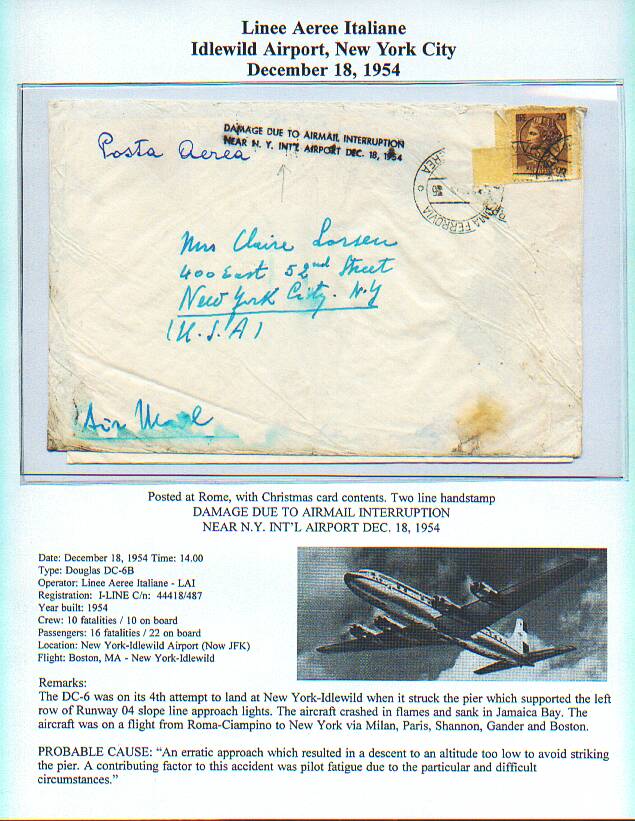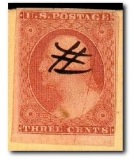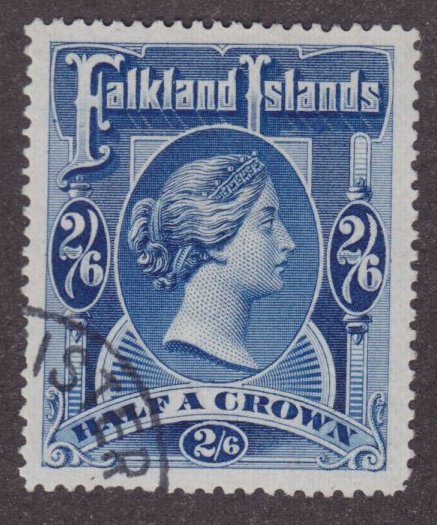
Discussion - Member to Member Sales - Research Center

Discussion - Member to Member Sales - Research Center

The LAI flight originated in Rome, stopped at Shannon, Ireland and Gander, Newfoundland to refuel, and flew on to Boston for more fuel and to disembark passengers. No doubt everyone, passengers and crew, were exhausted; LAI actually scheduled two flight crews on those long flights so that each crew could get some rest during the longer segments of the flight.
Idlewild has a pier extending into Jamaica Bay to supporting the approach landing lights that are commonly seen at all major airports. But the LAI pilot was too low on his last approach to the pier, struck the end of it, and plunged into Jamaica Bay. Only six of 22 passengers survived; all 10 crew were killed.
In writing about this, I’ve gone into the history of airline travel at mid-century, when airlines were often flying ex-military transports and the airline industry was beginning to see its potential as fast, safe transcontinental and transoceanic flight for people who previously had had to rely on ocean liners and trains to get where they wanted to go. The DC-6B airliner was almost new and among the most sophisticated airliners developed to that time. Here's a postcard picturing an LAI DC-6B:

I always try to find stamps, covers, and postcards to illustrate my web pages. I recently purchased this return postcard, flown by TWA in 1946 from New York City to the Vatican on the first postwar U.S. Air Mail Flight (F.A.M. 27), and immediately returned to the sender by the recipien (the image shows the postcard folded as it would have been as it passed through the mail stream). Unlike normal, used postcards, this one contains no message. That's because the o.nly reason for it to exist is as an artifact of an event seen as historic by a philatelist. As a result, its provenance is considered to be "philatelic" and of somewhat questionable commercial value.

Here's the postcard shown open, front and back:

The transit time for this postcard, to the Vatican from New York City and return, is interesting in light of how slowly the mail can move today. The postcard was postmarked in NYC on March 31, 1946, got a Rome receiver on April 2, arrived at the Vatican on April 3, and was postmarked for its return to New York City on April 4. It was precisely that speed that helped the airline industry attract passengers who would formerly have travelled by ship across the Atlantic.
Another cover I purchased at the same time as the return postcard is this First Flight Cover, commemorating LAI’s first flight from New York City to Rome (and back). Like the return postcard shown above, this cover is also philatelic:

The very word “philatelic” can be the kiss of death for cover collectors. All of us are searching constantly for “postally used” covers; there is a certain cachet to fusty old envelopes which have survived for multiple years or even decades even though the original sender and recipient never dreamed they would be saved from from the dustbin. But I believe that many early, purely philatelic covers (and postcards) deserve to be honoured for their role: Often they are provide the only evidence that mail travelled on particular airmail routes, or that anyone was paying attention to certain events.
Bob

1 Member
likes this post.
Login to Like.

12:04:58am
Nice additions, Bob. Is the tail number readable in that postcard?
Because here is the page from my "Crash Cover" album with a cover from that flight:

You will notice in my write-up (from the NTSB website), the tail number of the crashed plane was I-LINE
Roy

1 Member
likes this post.
Login to Like.
LAI — Linee Aeree Italiane (popularly known as Alitalia) flew the Douglas DC-6B for quite a long time, from 1953 until 1971.
Over several years, I’ve purchased four LAI postcards picturing the DC-6B. One is a photographic greyscale reproduction in sepia of a DC-6B on the tarmac at an airport; the other three are all artists’ renderings of the aircraft in the air. Two of the postcards show the planes’ registrations, but neither one is I-LINE. The one featuring the photograph indicates that the aircraft is I-DIMS; one of the ones reproducing a painting shows I-LYNX. Another postcard, though, is my favourite; it pictures an LAI Douglas airliner arriving over Manhattan, but there’s no way to know whether the aircraft is a DC-6B since only the left wing tip is visible and the description of the scene doesn't identify the model of aircraft.

There is little, at a glance, to distinguish a DC-6B from a DC-6, and even the DC-4 and DC-7 are similar enough to the DC-6 and its variants to cause confusion. Then there’s the Canadair DC-4M Northstar, which comprised parts from C-54/DC-4 and DC-6 airliners, was shortened by two metres, and was powered by Rolls Royce Merlin Engines, the same engines that the Spitfire flew during the Second World War. This postcard shows the Northstar’s distinctive air scoops, added to the aircraft to prevent engines from overheating in the very hot climates in some British Commonwealth countries:

Bob

4 Members
like this post.
Login to Like.
Exterior spotting clues:
Round vs square windows.
Four vs three blade props.
Extended fuselage.

Login to Like
this post

I’ve been researching the 1954 crash of a Douglas DC-6B airliner operated by Linee Aeree Italiane (or LAI, popularly known today as Alitalia). The crash happened at Idlewild Airport (Now JFK), after the pilot had made three attempts to land in inclement weather. He was advised to land at a nearby airport that had relatively clear weather, but he opted to try again. He shouldn’t have.
The LAI flight originated in Rome, stopped at Shannon, Ireland and Gander, Newfoundland to refuel, and flew on to Boston for more fuel and to disembark passengers. No doubt everyone, passengers and crew, were exhausted; LAI actually scheduled two flight crews on those long flights so that each crew could get some rest during the longer segments of the flight.
Idlewild has a pier extending into Jamaica Bay to supporting the approach landing lights that are commonly seen at all major airports. But the LAI pilot was too low on his last approach to the pier, struck the end of it, and plunged into Jamaica Bay. Only six of 22 passengers survived; all 10 crew were killed.
In writing about this, I’ve gone into the history of airline travel at mid-century, when airlines were often flying ex-military transports and the airline industry was beginning to see its potential as fast, safe transcontinental and transoceanic flight for people who previously had had to rely on ocean liners and trains to get where they wanted to go. The DC-6B airliner was almost new and among the most sophisticated airliners developed to that time. Here's a postcard picturing an LAI DC-6B:

I always try to find stamps, covers, and postcards to illustrate my web pages. I recently purchased this return postcard, flown by TWA in 1946 from New York City to the Vatican on the first postwar U.S. Air Mail Flight (F.A.M. 27), and immediately returned to the sender by the recipien (the image shows the postcard folded as it would have been as it passed through the mail stream). Unlike normal, used postcards, this one contains no message. That's because the o.nly reason for it to exist is as an artifact of an event seen as historic by a philatelist. As a result, its provenance is considered to be "philatelic" and of somewhat questionable commercial value.

Here's the postcard shown open, front and back:

The transit time for this postcard, to the Vatican from New York City and return, is interesting in light of how slowly the mail can move today. The postcard was postmarked in NYC on March 31, 1946, got a Rome receiver on April 2, arrived at the Vatican on April 3, and was postmarked for its return to New York City on April 4. It was precisely that speed that helped the airline industry attract passengers who would formerly have travelled by ship across the Atlantic.
Another cover I purchased at the same time as the return postcard is this First Flight Cover, commemorating LAI’s first flight from New York City to Rome (and back). Like the return postcard shown above, this cover is also philatelic:

The very word “philatelic” can be the kiss of death for cover collectors. All of us are searching constantly for “postally used” covers; there is a certain cachet to fusty old envelopes which have survived for multiple years or even decades even though the original sender and recipient never dreamed they would be saved from from the dustbin. But I believe that many early, purely philatelic covers (and postcards) deserve to be honoured for their role: Often they are provide the only evidence that mail travelled on particular airmail routes, or that anyone was paying attention to certain events.
Bob

1 Member
likes this post.
Login to Like.
BuckaCover.com - 80,000 covers priced 60c to $1.50 - Easy browsing 500 categories
02 May 2023
12:04:58am
re: 1954 airline disaster (LAI at New York City)
Nice additions, Bob. Is the tail number readable in that postcard?
Because here is the page from my "Crash Cover" album with a cover from that flight:

You will notice in my write-up (from the NTSB website), the tail number of the crashed plane was I-LINE
Roy

1 Member
likes this post.
Login to Like.

re: 1954 airline disaster (LAI at New York City)
LAI — Linee Aeree Italiane (popularly known as Alitalia) flew the Douglas DC-6B for quite a long time, from 1953 until 1971.
Over several years, I’ve purchased four LAI postcards picturing the DC-6B. One is a photographic greyscale reproduction in sepia of a DC-6B on the tarmac at an airport; the other three are all artists’ renderings of the aircraft in the air. Two of the postcards show the planes’ registrations, but neither one is I-LINE. The one featuring the photograph indicates that the aircraft is I-DIMS; one of the ones reproducing a painting shows I-LYNX. Another postcard, though, is my favourite; it pictures an LAI Douglas airliner arriving over Manhattan, but there’s no way to know whether the aircraft is a DC-6B since only the left wing tip is visible and the description of the scene doesn't identify the model of aircraft.

There is little, at a glance, to distinguish a DC-6B from a DC-6, and even the DC-4 and DC-7 are similar enough to the DC-6 and its variants to cause confusion. Then there’s the Canadair DC-4M Northstar, which comprised parts from C-54/DC-4 and DC-6 airliners, was shortened by two metres, and was powered by Rolls Royce Merlin Engines, the same engines that the Spitfire flew during the Second World War. This postcard shows the Northstar’s distinctive air scoops, added to the aircraft to prevent engines from overheating in the very hot climates in some British Commonwealth countries:

Bob

4 Members
like this post.
Login to Like.
04:55:38pm
re: 1954 airline disaster (LAI at New York City)
Exterior spotting clues:
Round vs square windows.
Four vs three blade props.
Extended fuselage.

Login to Like
this post

